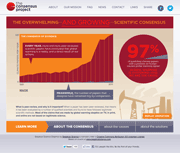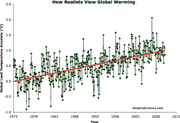Recent Comments
Prev 661 662 663 664 665 666 667 668 669 670 671 672 673 674 675 676 Next
Comments 33401 to 33450:
-
Tom Curtis at 01:12 AM on 21 October 2014Why ice sheets will keep melting for centuries to come
CBDunkerson @8:
1) Plausibly, the rate of ice melt is a function of the difference in temperature between the current temperature and the temperature at which the remaining ice would be in equilbrium. Given that in the 19th century, glaciers were expanding, it follows that they were at or below the equilibrium temperature and that hence we are not far of the equilibrium temperature for the current extent of ice sheets. On these assumptions, a rapid temperature rise will rapidly increase the disequilibrium and hence the rate of ice melt but need not do so significantly for several decades.
2) Plausibly the rate of ice melt is a function of exposed surface area of the ice, or perhaps the exposed edges of the ice sheets. The much smaller ice sheets current would therefore have a much smaller melt rate than those in the LGM to Holocene transition. Coupling both intuitions, we would need a far greater disequilibrium to generate the same rate of ice melt with todays smaller ice sheets.
3) Plausibly the rate of ice melt is also a function of the zenith angle of the sun durring the season of maximum melt. That zenith angle partially determines the rate at which energy can be absorbed by the ice sheet. The LGM - holocene ice melt had ice sheets at much lower latitudes and far greater summer insolation in the Arctic, both contributing to significantly higher zenith angles than is currently the case.
I am not saying that these intuitions are correct (although I strongly suspect the first two are, and think the third likely). My point is that they are reasonable intuitions that run counter to the intuition you rely on to conclude a very rapid ice melt (sea level rise). Given that there are plausible counter intuitions, I do not think we can rely on your intuitive argument.
-
CBDunkerson at 22:28 PM on 20 October 2014Why ice sheets will keep melting for centuries to come
Given that the current warming rate is vastly greater than anything in the natural record for the time period of this study, it stands to reason that the sea level rise rate should be at least as great as seen in past periods with similar amounts of ice. That apparently comes out to ~1.25 meters per century... which is consistent with some of the latest estimates (e.g. Rahmsdorf) of sea level rise by 2100 based on the currently observed rate of increase.
What this data, or any study of past climate change, is unlikely to be able to help us with any time soon is understanding how much greater the melt rate might be with the accelerated warming we are seeing, and how much of that future melt/sea level rise could be stopped if we succeed in reducing GHG emissions. There just haven't been any comparable situations which we can study.
-
CBDunkerson at 21:36 PM on 20 October 20142014 SkS Weekly News Roundup #42B
Miguelito, well...
The study doesn't say whether "it can work". Just that, currently, it doesn't. Could sensible regulations, better leakage controls, and carbon pricing allow natural gas to 'save the planet' by ending global warming? Maybe, but saying 'yes' based on this study is even less accurate than saying 'no'.
That said, to me it seems likely that the costs which would have to be added to natural gas in order to make it environmentally beneficial would also make it economically unfeasible. Solar and wind are already dropping below grid electricity rates in many countries. A carbon price reflecting the true cost of fossil fuels would instantly shift that to most of the people on the planet being able to get power from renewables more cheaply.
-
gpwayne at 15:57 PM on 20 October 20142014 SkS Weekly News Roundup #42B
Note to SkS: could you correct the error in which the Guardian article about Richard Tol is attributed to 'Bud' Ward, instead of his actual name - Bob?
Thanks...
Moderator Response:[JH] Correction made. Thanks for bringing this to our attention.
-
Rob Honeycutt at 14:03 PM on 20 October 2014Arctic sea ice has recovered
Interestedparty... I would highly suggest you read the SkS commenting policy before posting any further.
Moderator Response:[PS] It would seem that Interestedparty does not have the slightest interest in abiding the comments policy.
-
Rob Honeycutt at 13:35 PM on 20 October 2014Arctic sea ice has recovered
interestedparty... "...to comment on the obvious."
Therein lay the problem. You don't have to be an expert but you would need to have a little bit of humility regarding a complex field outside of your own when it comes to understanding what is, and what is not, "obvious."
What, pray tell, would you think is so obvious that specialists in the field have failed to already consider and include in their overwhelmingly agreed upon positions regarding man-made causation of global warming?
-
Miguelito at 13:18 PM on 20 October 20142014 SkS Weekly News Roundup #42B
Gawd, I hate misleading headlines.
"Natural gas won't save the planet, says new peer-reviewed report"
It should say "Natural gas without supporting policy won't save the planet, says new peer-reviewed report", because that's what the study says.
If there's good policy on things like curtailing fugitive gas and carbon prices, it can work. Otherwise, it's not going to help that much.
-
michael sweet at 13:04 PM on 20 October 2014Arctic sea ice has recovered
Interested party,
You would be better off studying climate science that chaos theory when you want to comment on a climate board. The natural trend now is cooling. Without human influence the temperature would be cooler. Your general comment seems to suggest it is impossible to know anything. Scientists feel we can learn and project what needs to be done.
Perhaps you can sugggest a specific topic you want to discuss and we can help you figure out what you want to learn.
-
sidd at 10:00 AM on 20 October 2014Why ice sheets will keep melting for centuries to come
there was more than twice present ice volume at the beginning of MWP1A. Fig 4 in the paper. -
wili at 08:14 AM on 20 October 20142014 SkS Weekly News Roundup #42B
Also relevant: Amazon deforestation picking up pace, satellite data reveals
Moderator Response:[JH] Thanks for the link. I'll include this article in the next News Roundup.
-
jja at 07:20 AM on 20 October 2014Dinner with global warming contrarians, disaster for dessert
Ok, so it is important to rebut obviously innacurate models (i.e. no pressure broadening and LW "windows" to space)
HOWEVER,
If the Durack et. al estimation is correct and ECS is now pushed much higher, (with associtated TOA values pre 2005 much higher) then we must conclude that the aerosol forcing factor is much greater (negative) than current models hold.
The implications are then that, as China has been radically reducing its sulfate emissions since 2011, we are seeing a regional NH spike in heating (though we are only now experiencing the warming increases).
Further implications are that the anthropogenic signal may now be accurately extracted from the 1910 to 1975 global temperature regime.
If this is true, it changes everything. near and long term temperature responses, incresed near-term land based and permafrost carbon cycle feedbacks, increased regional rainfall and land-based temperature extremes, radically incresed long-range projections for sea level rise. And all of these produce an accelerated damage function in the IAMs leading to an estimation of the social cost of carbon greater than $300.00 per tonne CO2e (with a completely immoral and indefensible 3% pure-time multigenerational discount rate)
In short. If these implications are correct, we have crossed a threshold where mitigation discussions must now take on the urgency as an existential threat, without prejudice. -
wili at 05:33 AM on 20 October 20142014 SkS Weekly News Roundup #42B
Good point. MSM generally don't connect the dots very well. I'd be interested to hear what you think of this fellow's take:
Moderator Response:[JH] RobertScribbler's article is interesting.
-
wili at 04:52 AM on 20 October 20142014 SkS Weekly News Roundup #42B
Thanks. I had searched "Sao Paulo" and came up with nothing. I'm not seeing a lot related to the most recent development ins SA using that search term either. I just wanted to give you a heads up that a major climate story/catastrophe is developing in SA that you may want to look into a bit more. Thanks for all your other coverage.
Moderator Response:[JH] I have scanned many articles about what's happening in Sao Paulo, but have not come across any that link the drought to climate change.
-
hank at 02:58 AM on 20 October 2014IPCC admits global warming has paused
Aside — you'll find many 'septic' sites posting a partial quote from Al Gore's 2007 Nobel acceptance speech (one way to identify that sort of misattribution and spin is to look for their copypaste repeats of the partial quote).
Here it is in context:
"Last September 21, as the Northern Hemisphere tilted away from the sun, scientists reported with unprecedented distress that the North Polar ice cap is "falling off a cliff." One study estimated that it could be completely gone during summer in less than 22 years. Another new study, to be presented by U.S. Navy researchers later this week, warns it could happen in as little as 7 years."
The US Navy research: http://scholar.google.com/scholar?q=maslowski+2007+arctic&hl=en&as_sdt=0%2C5&as_ylo=2007&as_yhi=
-
Hans11230 at 07:17 AM on 19 October 2014Breathing contributes to CO2 buildup
And of course I agree with what I have read somewhere that the extra 3 billion people are an extra sink of Carbon.
-
wili at 06:34 AM on 19 October 20142014 SkS Weekly News Roundup #42B
Have you included any articles about the drought in much of Brazil (and in Central and South America for that matter)? Sao Paulo, the largest city in SA, in particular is on the verge of running out of water and having to turn to much-lower-quality reserves. CA is not the only dry spot in the world.
Moderator Response:[JH] You can readily answer your question by inserting "South America" into the SkS search engine.
-
Hans11230 at 06:17 AM on 19 October 2014Breathing contributes to CO2 buildup
I'm sorry to bring up this subject again, but I've only just been introduced to this platform. I have had no previous opportunity of discussing whether " Breathing contributes to CO2 buildup "?When we replace forests bij vegetable fields a lot less carbon is stored in vegetable fields than in forests. The forest canopy is higher and permanent while vegetables are also a seasonal crop.
The differrence in carbon storage has been burned and is introduced into the atmosphere. Therefore 7 billion people needing more crops than 4 billion people will subsequently have displaced carbon from storage in forests to the atmosphere. This is added to the GHG. Breathing will not further increase the amount of GHG as we have to keep growing crops to keep the cycle in balance.
So yes there should be more GHG and I think you can feel this in your bones. But its in facilitating our food that crops are a far less functional temporary carbon sink.
And breathing does NOT contribute to a buildup of CO2 as we will allways have to cultivate new crops to ensure a continual supply to enable future bre -
jja at 02:32 AM on 19 October 2014Why ice sheets will keep melting for centuries to come
Even the PETM took 10,000 years to advance to a hothouse state.
RCP 8.5 will create a hothouse earth within 200-300 years. -
Phil at 22:30 PM on 18 October 2014How did the UK grid respond to losing a few nuclear reactors?
For a brief time early this morning, Wind was the second largest contributor to the UK grid, and came within a whisker of being the largest
Time Coal Wind CCGT Nuclear 5.20am 5.87 5.578 5.316 4.343 6.20am 7.321 5.99 5.956 4.337
(figures in GW)
Obviously this is cherrypicking; demand at this time is at its lowest, and wind conditions appear to ideal for power generation at the moment. Nevertheless it does indicate that the UK grid can accomodate a substantial proportion of wind power. The interconnector to Holland was also fully importing, suggesting that mainland Europe also had an abundance of wind energy.
Data from www.gridwatch.templar.co.uk/
-
Glenn Tamblyn at 15:55 PM on 18 October 2014CO2 effect is saturated
Jonathon
See my comments attached to your video.
-
Jonathan Doolin at 14:06 PM on 18 October 2014CO2 effect is saturated
I put together A 20 Minute Video that attempts to explain some of my current thinking. I don't think I have any current questions...
KR, Thanks for the reference to Harries. But at $32 to read the article, or $199 to get a year's subscription to nature. I'm going to try to figure it out on the cheap.
Moderator Response:[DB] Try here.
-
scaddenp at 11:42 AM on 18 October 2014Dinner with global warming contrarians, disaster for dessert
Most significant climate papers are published in journals that have a larger base than climate science and so have same process as all the other disciplines. I do hope you will further at the dispersions cast on scientists and peer review than just the misrepresentations by "skeptics". It is not often you get mass resignations of journal editors.
-
Bob Loblaw at 10:56 AM on 18 October 2014Dinner with global warming contrarians, disaster for dessert
Ashton:
Yes, there have been some rather poor practises in peer review in climate science. In addition to the links provided by DSL, I suggest you take a look through this article chronicling Pal Review.
-
mbryson at 10:55 AM on 18 October 2014Why ice sheets will keep melting for centuries to come
Riduna: I agree— when it comes to events like that, preparing for the more extreme scenario is wise, even if we think it's unlikely. It's called insurance, it makes sense when we can't afford a potential loss, and this case meets that description in spades.
-
mbryson at 10:52 AM on 18 October 2014Why ice sheets will keep melting for centuries to come
Ranyl: Your first question is the one I logged on to ask. I can understand that the amount of ice makes a big difference, but the rate of warming now, as I understand it, is much higher than at the end of the last ice age. So an inference about likely rates of sea level rise in the future based just on the amount of ice seems to leave something important out.
-
Bob Loblaw at 10:50 AM on 18 October 2014Dinner with global warming contrarians, disaster for dessert
Please take this as an entirely tongue-in-cheek look at publications and citations, but as soon as I read this thread I was reminded of the old chain-mail take on how to get tenure. I easily found the full text online at this location, with a bit of background info on its origin, but here it is for local fun. I particularly enjoy the third paper cited.
Dear Fellow Scientist:
This letter has been around the world at least seven times. It has been to many major conferences. Now it has come to you. It will bring you good fortune. This is true even if you don't believe it. But you must follow these instructions:
- Include in your next journal article the citations below;
- Remove the first citation from the list and add a citation to your journal article at the bottom;
- Make 10 copies and send them to colleagues.
Within one year, you will be cited up to 10,000 times! This will amaze your fellow faculty, assure your promotion and improve your sex life. In addition, you will bring joy to many colleagues. Do not break the reference loop, but send this letter on today.
Dr. H. received this letter and within a year after passing it on she was elected to the National Academy of Sciences. Prof. M. threw this letter away and was denied tenure. In Japan, Dr. I. received this letter and put it aside. His article for Trans. on nephrology was rejected. He found the letter and passed it on, and his article was published that year in the New England Journal of Medicine. In the Midwest, Prof. K. failed to pass on the letter, and in a budget cutback his entire department was eliminated. This could happen to you if you break the chain of citations.
1. Miller, J. (1992). Post-modern neo-cubism and the wave theory of light. Journal of Cognitive Artifacts, 8, 113-117.
2. Johnson, S. (1991). Micturition in the canid family: the irresistible pull of the hydrant. Physics Quarterly, 33, 203-220.
3. Anderson, R. (1990). Your place or mine?: an empirical comparison of two models of human mating behavior. Psychology Yesterday 12, 63-77.
4. David, E. (1994). Modern Approaches to Chaotic Heuristic Optimization: Means of Analyzing Non-Linear Intelligent Networks with Emergent Symbolic Structure. (doctoral dissertation, University of California at Santa Royale El Camino del Rey Mar Vista by-the-sea).
-
Riduna at 10:25 AM on 18 October 2014Why ice sheets will keep melting for centuries to come
“When starting with double the modern ice volume or less, sea levels did not rise faster than 2m per century”
Not quite. Meltwater pulse 1A produced SLR of 200m in a thousand years some 14,000 years ago. What unprecedented AGW is now doing to climate and OHC indicates that average global sea level rise this century is going to be a lot more than current predictions of 1m by 2100.
Governments should be planning on SLR of at least 2-4m by 2100 rather than relying on conservative assessment such as this.
-
Firgoose at 07:35 AM on 18 October 2014Why ice sheets will keep melting for centuries to come
I read that in The Conversation a while back and the comments are worth reading as well. Professor Rohling was very responsive.
The Read the original article link at the end of the article above has a digit missing from the conversation id, hence clicking it will lead you to discover more than you realised you needed to know about incontinence in young women. ;o)
Here's the actual conversation
Moderator Response:[JH] Link fixed. Thank you for bringing this to our attention.
-
DSL at 06:22 AM on 18 October 2014Dinner with global warming contrarians, disaster for dessert
Ashton: "I'm not sure what the peer review process really is in Climate Science, although some disquieting emails on peer review in Climate Science were brought to light a few years ago."
Yes, that's true Ashton. The Soon & Baliunas (2003) affair was fairly disquieting. The Wegman affair was as well. But perhaps it's these emails that you're referring to, addressed to the Met Office's Phil Jones.
-
Ashton at 03:49 AM on 18 October 2014Dinner with global warming contrarians, disaster for dessert
I'm not sure what the peer review process really is in Climate Science, although some disquieting emails on peer review in Climate Science were brought to light a few years ago. I suspect it probably is no different from the peer review pocess in my own area where I never found out who peer reviewd the papers I submitted. On publishing in open journals, which seem to be a lot less rigorous in their scrutiny of submitted papers, I write seem as I haven't submitted to such journals, it does add to the body of published work by an academic. Although this may not enhance his/her standing in their particular scientific community, it could be very advantageous in internal applications for promotion where a long list of publications can have a ssignificant positive impact on the university promotion committee
-
ranyl at 02:15 AM on 18 October 2014Why ice sheets will keep melting for centuries to come
Thank you Eelco Rohling,
1m is reassuring as you say.
However what scale and rate of heating forcing was that reacting to?
And does the current unprecendented rate of warming mean things might more quickly?
-
Dikran Marsupial at 00:56 AM on 18 October 2014Dinner with global warming contrarians, disaster for dessert
CBDunkerson, I don't think that is necessarily the case, there are comparatively few skeptics, so even if they all cite every paper each of them writes, that is still a relatively small number of citations for any given paper, compared to the available citations available from the research community in general. A basic newtork analysis would expose their gaming of the system, so there would be little to gain from it.
However, I was more thinking of acedemia in general rather than climate science in particular. If academics no longer have an incentive to write papers that nobody cites (i.e. that everybody ignores), there will be no profit in running a predatory open access journal.
-
CBDunkerson at 21:44 PM on 17 October 2014Dinner with global warming contrarians, disaster for dessert
Dikran wrote: "One possible solution to this problem is to make promotions etc. for researchers contingent on the citation of their papers rather than merely the existence of the papers themselves."
Unfortunately, I doubt that would work for very long. Given the established willingness of 'skeptics' to game the system, changing the details of the sytem will just mean a brief period of clarity until they adjust by changing their gaming strategy. In this case... if citations are the determinant it seems inevitable that groups of 'skeptics' would get together and cite each other's papers en masse. Even legitimate scientists might be tempted to cite a friend's tangentially related work just to 'help them out'.
Unless some 'ungameable' benchmark can be established, switching the benchmarks only serves to make an even bigger mess in the long run as each standard is deliberately corrupted in turn.
An alternate approach is to play 'whack-a-mole' with each effort to undermine the current standards. In this case, if we take the problem to be publication of dubious research in journals with low standards, a solution might be to establish a means of identifying such journals and excluding them from consideration. No doubt this would lead to cries of 'bias' and 'censorship', but the reality is that various forms of publication (blogs, vanity press, un 'reviewed' papers, et cetera) are already excluded. This would just move the line slightly from including 'anything even ostensibly reviewed' to 'anything reviewed in a remotely competent manner'.
-
Glenn Tamblyn at 20:34 PM on 17 October 2014Dinner with global warming contrarians, disaster for dessert
"Everything else is colored blooming nonsense."
You've gotta love a slap down with style...
More broadly, one day the psychologists are going to be able to mine the history of fringe climate denial to nail down the specific brain centers where Dunning Kruger originates.
......SORRY. Totally OT. But this totally cracked me up. From the WP article on the DK Effect:
"The study was inspired by the case of McArthur Wheeler, a man who robbed two banks after covering his face with lemon juice in the mistaken belief that, as lemon juice is usable as invisible ink, it would prevent his face from being recorded on surveillance cameras"
-
Dinner with global warming contrarians, disaster for dessert
Ashton - The Lindzen and Choi paper was discussed on this thread. Nothing new from the previous 3-4 papers on the same topic, no addressing of the multiple rebuttals and previously demonstrated errors.
The Harde papers references of Lindzen et al 2001, Spencer and Braswell 2011, Salby 2012, Ludecke 2011, etc, are rather blatant examples of relying on wholly debunked works without referencing any of the later and contradicting literature.
-
Dinner with global warming contrarians, disaster for dessert
A response from Dr. G. Kramm (who is well published in climate studies) on the earlier EIKE thread promoting Harde states (again, my apologies for auto-translated German) with respect to Hardes paper:
[Notes that Harde hasn't cited relevant works]... The rivers of sensible and latent warmth allowed to be calculated only according to local temperature and humidity distributions. Everything else is colored blooming nonsense.
-
Dinner with global warming contrarians, disaster for dessert
Hermann Harde has commented regarding his paper on the EIKE website (German climate denial lobbying group), which has been promoting his paper. My German is quite poor, so I'm relying on Google Translate for this - I expect fluent readers to have more clear information. Some notes and statements from that comment:
- Harde is retired, writing on climate in his spare time.
- "...but generally about the greenhouse effect. It is almost nonsense, of a self-heating mechanism or Perpetuum Mobile to talk..." -this is Gerlich & Tscheuschner level nonsense, and in fact a term straight from G&T; the greenhouse effect is not invalidated by thermodynamics.
- "That the CO2 concentration increases delayed (by Prof. M. Salby about 9 months) due to heating caused mainly by increased solar activity, no one disputes in this county. This has only effect that so climate sensitivity is additionally influence as a feedback or gain to the solar sensitivity." - No, it's not the sun, CO2 increases over the last century are _not_ due to the warming ocean, as oceanic concentrations are rising too, and Salby's nonsense is demonstrably just that.
- "...GCMs turns out here so great that all were not able one and all and to indicate the climate evolution of the last 17 years and also for the near future..." - Ah, the inevitable 'hiatus' comment...
- "Limitations to this, it is only at a underlying thermally induced cloud feedback in the superimposed oscillations and can change the feedback coefficients." - The only feedback in his model appears to be a fixed cloud scaling with temperature. I cannot find any reference to water vapor or specific humidity.
- "Circulation and exchange between different zones I do not treat as a global ECS and no climate sensitivities of individual zones are considered here." - A _very_ simple model.
His starting point is rather worse than I had expected, loaded with climate denial myths. And while his radiative model is quite complex (228 layers - as I understand it line by line radiative code converges asymptotically after about 40 layers), his climate model and it's response to CO2 changes is clearly inadequate to the task.
-
ajki at 15:25 PM on 16 October 2014Dinner with global warming contrarians, disaster for dessert
When I read the name "Harde" I had the bad feeling that another G&T embarassment might show up. To my relief the Rabett states: "Harde's stuff is of a much higher quality than the G&T joke."
But it may well not be much higher, either. The citation base seems to be grounded on known outliers (Lindzen, Spencer...), even Vahrenholts "Kalte Sonne" gets cited. How low can you possibly go? And then this brave retired man gets his applause from web sites like EIKE or "science skeptical" (a kind of german SkS travesty). Like G&T it is one of those 450+ "papers" that EIKE uses to show the real true truth that everything from the Alarmistas is wrong and fabricated (and they never turn down anything from that ongrowing list, even if so debunked and burned that the authors themselves do not mention it anymore).
-
Joel_Huberman at 15:15 PM on 16 October 2014Ocean Warming has been Greatly Underestimated
A fascinating article. Thanks, Rob. You've persuaded me that it will be worth my while to read Durack et al. in detail. I hope others, who are more knowledgeable, will comment on the fascinating/frightening implications that jja (@1) sees in the results of Durack et al.
-
Rob Honeycutt at 13:22 PM on 16 October 2014Scientist in focus – Arctic adventurer Will Steger
wili... It's just from conversations I've picked up from reliable people. And the fact that I am hesitant to assign intent (to exclude) when there's no particular reason to believe it's there.
-
wili at 12:00 PM on 16 October 2014Scientist in focus – Arctic adventurer Will Steger
"too much being read into what actually happened"
That can certainly happen. Do you have any basis for the claim, besides the interesting points you've already shared?
-
Bob Loblaw at 11:56 AM on 16 October 2014CO2 effect is saturated
Jonathan:
What KR and Glenn said. Scattering and absorption/re-emission are different beasts.
Wikipedia actually has an article on Rayleigh Scattering, which in the atmosphere is the scattering caused by the air molecules themselves. Ditto for Mie Scattering, which in the atmosphere is caused by all the particulate matter. In fog, also add reflection (including internal - i.e., inside the water droplets). And in all cases, expect multiple scattering - light that is scattered many times, sometimes to the point where you can't tell up from down (white-out in a blizzard).
-
Bob Loblaw at 11:48 AM on 16 October 2014CO2 effect is saturated
Glenn @ 308:
A good catch. I had realized that figure 7.3 in that source was not covering the peak absorption wavelengths - hence my reference to figure 7.2 where the right side shows much greater absorption.
Other references I had on hand gave absorption coefficients with units such as kg/m2. When using Beer's Law, you must be careful of units, and typically simple distance (e.g., metres) isn't one you'll see because distance isn't a measurement of the amount of gas - you need density, pressure, etc. to get the full picture. I wasn't about to try to figure it out late at night, and missed the context of figure 7.1. I had also looked at table 7.1 in that document, which gives several possible units for path length, including "cm" and "cm atm". I don't think either one of them is intended to be simple linear distance.
It is possible to measure gas amount in length units, but the length isn't ordinary distance. Take ozone for example, where a Dobson Unit (a common measure of total column ozone) represents a thickness of ozone of 10 µm, when compressed to standard tempeature and pressure. The WIkipedia page also calls that a "milli-atmo-centimeter", so I'm going to guess that the "cm atm" unit in table 7.1 is a similar measure. Thus, just because an absorption coefficient has units of length doesn't mean the path length is really distance or height.
The data from figure 7.1 does definitely appear to represent a physical path in the free atmosphere of 1 metre, though. They refer to 100 and 1000 mb as the pressure, and "typical CO2 concentration".
The PDF file I linked to appears to be just one lecture in a course on atmospheric radiation, and the course syllabus is available here. It looks like it has a lot of interesting material.
-
Rob Honeycutt at 11:42 AM on 16 October 2014Scientist in focus – Arctic adventurer Will Steger
wili... I get the sense there is too much being read into what actually happened.
-
wili at 10:56 AM on 16 October 2014Scientist in focus – Arctic adventurer Will Steger
Thanks for the insights and links. As far as I've seen, no one is questioning their actual published data in any severe way, so it seems they should be heard. I have not heard of any scientists excluded for their scientific reticence about extrapolating negative info, so I think it is a bad precedence for peopl who err slightly on the other side. I would say the former (reticence), all in all, is ultimately more...problematic.
-
Rob Honeycutt at 08:32 AM on 16 October 2014Scientist in focus – Arctic adventurer Will Steger
wili... I saw a little bit about this and it sounded like they were not actually excluded but the RS just couldn't reschedule on demand to accomodate them. Apparently it was a session where only about 18 or so people were invited, so they were not the only people who weren't invited.
On the methane bomb... There seem to be a lot of good scientists who are skeptical of this idea. Richard Alley, I believe is one who states something along the lines of, maybe, but probably not anytime soon. I've seen others state that magintudes are insufficient to compete with CO2.
Peter Sinclair just recently posted a couple of interviews related to this issue.
-
scaddenp at 08:05 AM on 16 October 2014Scientist in focus – Arctic adventurer Will Steger
Wili - the issue I think, is not with Shakhova's science and observational contributions, but more with somewhat alarmist extrapolations from them.
I notice that David Archer responded to you on this very issue here. Modelling doesnt support a methane monster.
-
wili at 07:24 AM on 16 October 2014Scientist in focus – Arctic adventurer Will Steger
(That is, of course, not to take anything away from Will Steger! I admire him greatly, have heard him speak and am pleased to live in the same metropolis as both he and John Abraham do.)
I just realized that I didn't link that correctly--some people never learn :-/
I'll try again: Ignoring the Arctic Methane Monster: Royal Society Goes Dark on Arctic Observational Science -
wili at 07:13 AM on 16 October 2014Scientist in focus – Arctic adventurer Will Steger
I would count any scientist who works in such extreme conditions to also be an 'explorer.' Last year a ship of scientist was in danger in a storm in the Arctic. They were saved, but many who went to save them perished.
Two such brave explorer/scientists are Igor Semiletov and Natalia Shakhova. They just returned from another long and dangerous voyage studying this critical region only to find that, in spite of being the two scientists with the longest history of working in the area, they were excluded from a session at the Royal Academy on just this topic.
Does anyone know what is going on here?
http://robertscribbler.wordpress.com/2014/10/15/ignoring-the-arctic-methane-monster-royal-society-goes-dark-on-arctic-observational-science/
-
jja at 06:55 AM on 16 October 2014Ocean Warming has been Greatly Underestimated
In addition, a higher GHG forcing and stronger aerosol effect would reveal anthropogenic impacts on 1910-1975 warming trends as well as lend increased weight to Ruddiman et. al (2011) http://www.whoi.edu/pclift/Ruddiman.pdf
Prev 661 662 663 664 665 666 667 668 669 670 671 672 673 674 675 676 Next































 Arguments
Arguments



























